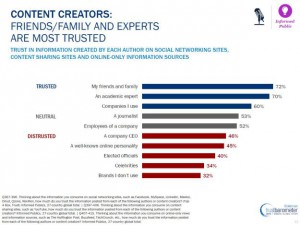We read curated news feeds, not media statements.
We read other people’s product reviews, not those of the provider.
We want to hear advice from friends or experts, not senior management.
So why should people trust your organisation?
The Edelman Trust Barometer has been tracking the way consumers absorb and share information since 2001. The importance of experts and peer-to-peer in building trust, is a consistent theme, along with the changing way that we use the Web. We search for exactly what we want, rather than browse one source and trust what we read.

This is best summed up in Richard Edelman’s interview with Harvard Business School.
On media and the role of search:
Well, media’s now distrusted in two-thirds of the countries we survey. And ‘search’ is actually the first place people go for information and also to corroborate information, so it’s no longer to mainstream media brands, whether television or print. It also implies the rise of the so-called ‘born digital’ Business Insider, courts, BuzzFeed, that are more search optimized, as well as the wire services. So people are skeptical about the media. They feel it’s very opinionated. And they are nervous about what they’re reading and whether it’s getting the straight story.
On authority, friends and the role of staff:
We really can observe over these 15 years, a tremendous dispersion of authority. When you see that the least trusted spokespeople are CEOs and government officials. Who’s most trusted? Well, it’s an academic or it’s a person like yourself. You know, friends and family are the number one trusted source on social media. Well above celebrities, like, 3X celebrities. So, again, it is this move away from the very well organized world of three networks and the president saying and people believing. Or even the CEO. It now has to be done through employees and a sort of, more dispersed world of communities and others.
What does this mean for an organisation wanting to share something with its customers? You have two options:
1. Work with staff, supporters, loyal customers: they know your product or service inside out, can answer technical questions and present your message in a way that others understand. They do this by using the same language as your audience, or through their favourite channels, or both.
Look at the accessibility of IBM staff on Twitter, or GiffGaff’s customer community.
2. Work with partners: stakeholder organisations, single interest groups, and charities are great at attracting and organising people with a common goal or passion. Ask yourself: what can you give these partners, that will offer value to their audiences? This could be content, access to expertise, or a means of having their voices heard.
